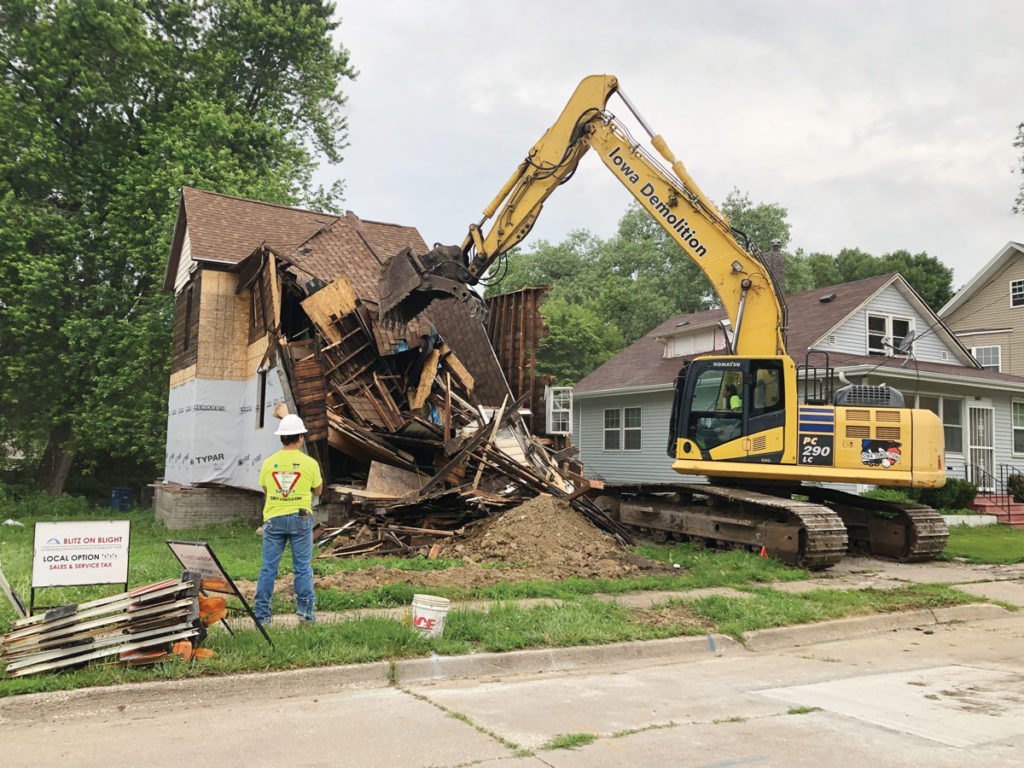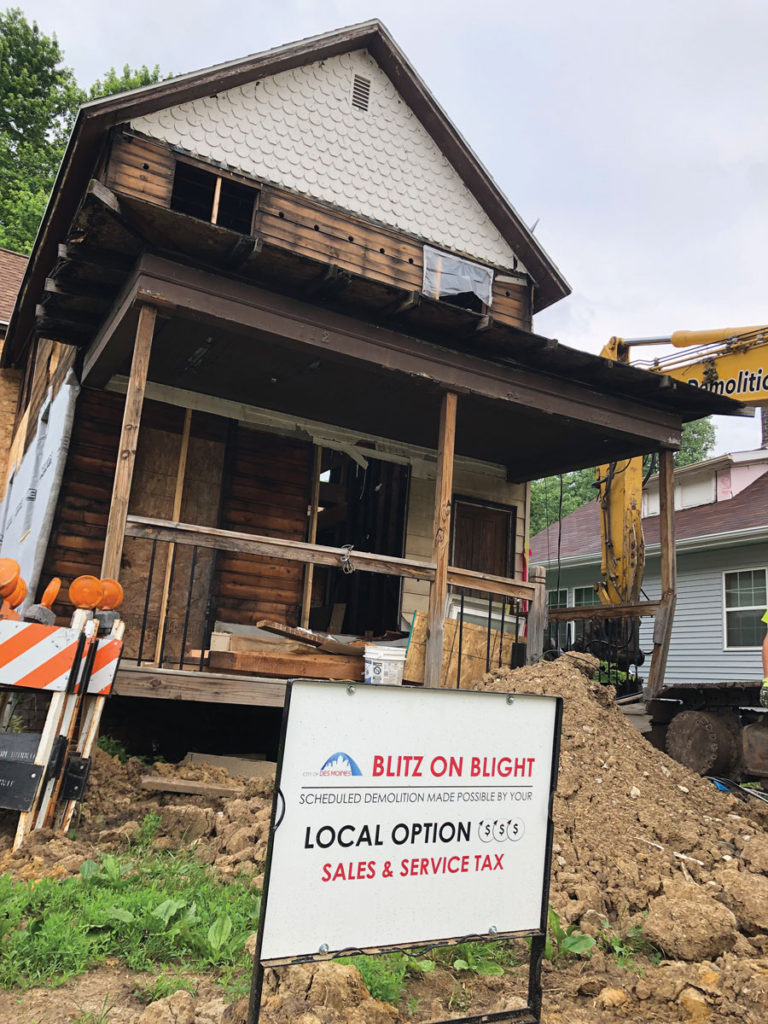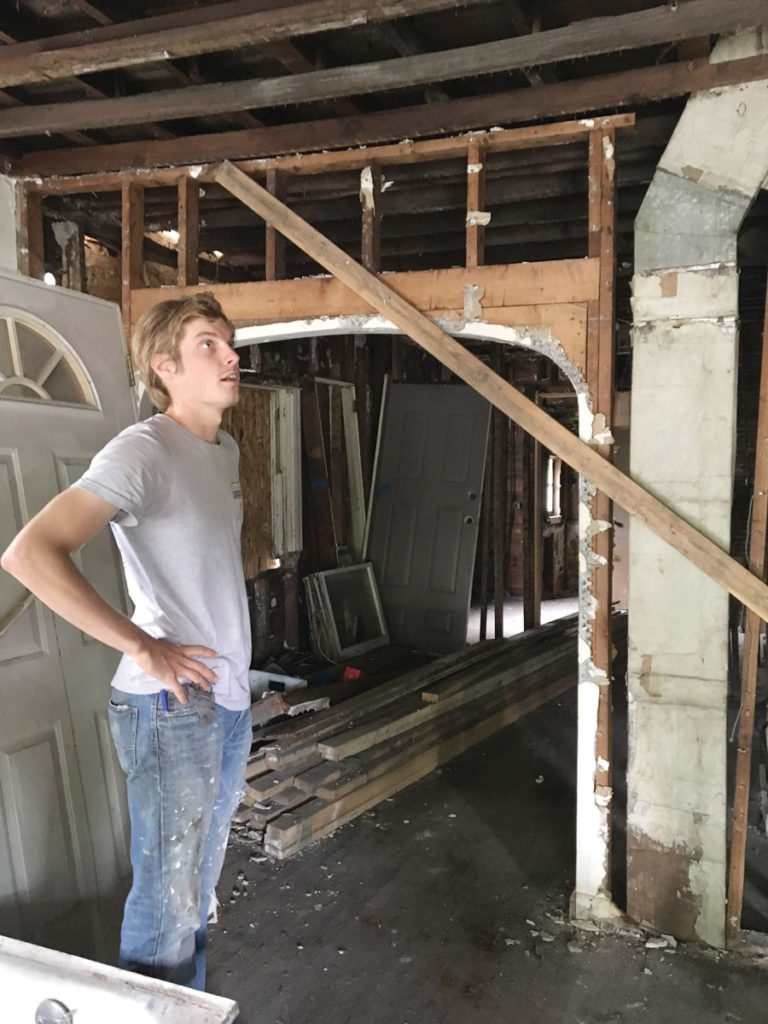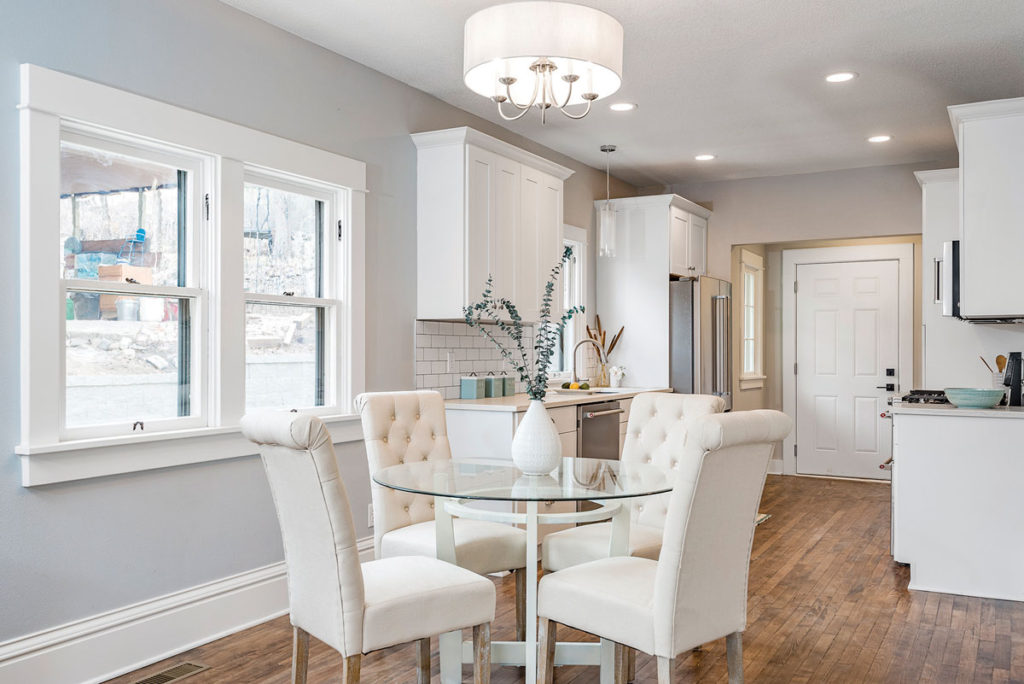Blitz on blight
7/3/2019Des Moines leaders target nuisance property owners.

Des Moines city leaders will be more aggressive with nuisance properties now that they have the money to demolish them.
Officials hope income from the local-option sales tax will give them a boost for their “Blitz on Blight” campaign that will target more than 200 properties — some of which city council members declared public nuisances at least a decade ago — within Des Moines.
Although the new sales tax did not go into effect until July 1 (voters approved it in March), city officials had already scheduled or demolished 11 homes, some of which had been declared nuisances years ago. City officials have earmarked $3 million in sales tax money a year toward the “Blitz” initiative. Previously, they were limited to spending $200,000 a year in grant money, which could only be used in particular areas of the city depending on the neighborhood income level, says Chris Johansen, the city’s community development director.
“What was happening is that, in certain parts of town, we couldn’t use our existing funds. So those structures sat, and it wasn’t enough funding to handle the homes in our backlog,” he says.
City officials will now be more aggressive in naming properties as public nuisances, Johansen says.
A public nuisance, according to city code, is any structure, dwelling, mobile home or premise that a city inspector finds to be unsafe or dangerous, or when those structures or dwellings are found unfit for human occupancy. Any structure or dwelling that is declared a nuisance is required to be vacated and the nuisance abated at the owner’s expense.
City employees have compiled a list of the worst properties, based on the number of years they’ve been a nuisance, as well as how much heat they’ve gotten from neighbors in the area about the property, to demo first.
Crews from Iowa Demolition tore down the house at 1126 11th St. on June 19. Attempts to reach the owner by phone were unsuccessful. According to City and Polk County Assessor records, the house was damaged in a fire.
Of the 11 properties on the initial “Blitz” list, five were owned by an individual who had died. Phone numbers were unavailable or out of service for the owners of four of the houses.
Another, located at 1547 Fourth St., is owned by the now-defunct Oak Park Investments LLC, a limited liability company in Chicago. The company now has a new name, and a company representative who oversees the Iowa properties said she could not comment on the property and to call at a later date.
“It’s very rare that someone is living in it when we start looking at it,” Johansen says.
Owners die, others abandon homes

On average, about 200 properties a year are deemed public nuisances. There are likely dozens more, city officials say, but they haven’t had the resources to pursue those properties until the sales tax money became available. The average cost to tear down a nuisance house is $30,000, so it wasn’t worth city officials’ time or taxpayers’ money to go through the filings and legal process of having a house declared a nuisance, Johansen says.
About six or seven houses were torn down each year under the previous budgeted amount of $200,000.
“Our frustration is that these would always sit there, and now we’re making an attempt to take some stuff down,” says Jim Nelson, neighborhood inspections supervisor for the City of Des Moines.
The oldest property has been on the public nuisance list since 2006. With all of the properties, city inspectors check in every few months to determine whether there’s been any progress on the building, he says.
Part of the delay is the process itself. After an initial complaint is filed, an inspector investigates, notifies the property owner and posts a notice on the door that the property is unsafe. The City Council then orders city attorneys to file court papers to have the house declared a public nuisance. A hearing is scheduled. City officials contact the owner to see whether he or she agrees to renovate the property. Then city inspectors request council members’ permission to demolish the house.
This doesn’t take into account the time to track down the property owner, give him or her a timeline and re-inspect if the owner agrees to make improvements, or to go through the legal proceedings. Sometimes the property owner hasn’t paid the taxes, so there’s a lien on the property, which further delays the process. In some cases, it can take five years or more to have a property declared a public nuisance.
In other cases, the homeowner has died and no one claims the property or wants to take care of it. Some homes are damaged from fire, and then the homeowner abandons the house.
“There’s a lot of homes in Des Moines that after they own them free and clear, people stop paying their insurance on it,” Johansen says. “If there’s a fire in the home and there’s no insurance, the house sits fire damaged. Those are the first ones we’ve been going after to get demolished.”
The majority become a nuisance from neglect. In the city, inspectors enforce upkeep for rental properties. The same requirement is not mandated for private property.
“You could sit and let that thing rot, and there’s nothing the city code or inspection could stop you from doing until it gets to disrepair that becomes a public nuisance,” Johansen says.
Once a house is demolished, the homeowner still owns the land. Only now there’s a lien on the property title for the price of the demolition, which adds more cost to the potential for redevelopment of the vacant lot, Johansen says, or it creates the potential for an overgrown weed-filled lot to take the place of the house.
“It’s not an easy system,” he says.
That’s why city officials work with county tax and land records officials to try to waive some of those fees for developers who want to build on the sites. Johansen says another possible solution is to foreclose on the property with the city obtaining ownership and then selling the land to a developer.
Ryan Francois, co-founder of Rally Cap Properties, says his company has passed on several properties because the legal fees and assessments for boarding up the house, cutting down weeds and other work has been too high. It can be $1,000 at the low end but up to $10,000, which is too much extra expense for a project that is already financially challenging, he says.
Developers revitalize nuisance properties

Not all public nuisance properties end in demise. Anytime officials consider whether to demo a home, it undergoes an evaluation to determine its historic significance, especially if it’s located in the River Bend, Drake or Sherman Hill neighborhoods, Johansen says.
“A lot of those, we don’t tear down,” he says. “Some we do, but a lot we don’t if they have some historical significance or if there’s an opportunity for the home to be rehabbed.”
Since 2016, Rally Cap Properties has purchased several homes, some of which were former public nuisances, in the Woodland Heights, Waveland, North of Grand, Roosevelt and Sherman Hill neighborhoods. Two of those were the houses at 740 26th St., known as “High Lawn,” and at 726 27th St.

Rally Cap bought the properties from an Omaha investment company that had owned them for a while but did nothing, Francois says. The properties the company purchases have come from tax sales, were neglected and let go, or even damaged by fire.
“We didn’t set out with a focus on nuisance properties specifically but found that oftentimes we have been able to get the best return on those properties,” Francois says. “When it comes to neighborhood revitalization, I believe the vacant, nuisance properties are the low-hanging fruit. Fewer investors are willing and able to take on the historic homes that have been neglected or boarded up, so we can purchase lower and invest much more into our renovations.”
Francois says rehabbing a nuisance property can take years. There can be title issues or multiples investors who have purchased tax sale certificates. The owners are often out of state and difficult to reach. The 26th Street properties took more than a year to close even after Rally Cap had found and contacted the legal owner.
The work to rehab the property also can take time, especially if it’s being paid for, in part, with historic tax credits, Francois says.
“The city has been very reasonable with the timeline on our past nuisance projects as long as we show progress during regular check-ins by the neighborhood inspector,” he says.
The rehabilitation process would go smoother and quicker, and more houses would be saved, if landowners with nuisance properties didn’t dig their heels in and wait, Francois says.
“Oftentimes, landowners with nuisance properties don’t get motivated to sell until the last minute when the threat of significant fines or demolition become a real possibility,” he says. “If sellers are proactive, it avoids a lot of expense and hassle for everyone, and there is a better chance of something positive happening with the home.”
The City does offer $100,000 a year for rehabilitation through the Blighted Property Rehabilitation Program, but that money doesn’t go far when it can cost $30,000 to restore a bad foundation, Johansen, the community development director, says.
Trevor Williams, the chief operating officer of DSMBLC Holdings LLC, has invested hundreds of thousands of dollars into revitalizing historic homes in Des Moines. His company took two large houses on 26th Street that had been converted into rental units and become public nuisances and made them single-family homes again.
Williams is a fifth-generation carpenter, and his family has been in the construction business since 1887. He has worked in the construction real estate business himself for 20 years but started following his interests and moved to historic preservation nine years ago. His renovations keep the historic character of the house minus modern bathrooms and a kitchen.
He rehabilitated the houses at 1070 and 1074 26th St. in 2017 and 2018. City employees helped Williams acquire the properties before they were lost in a tax sale. They had been converted to multi-family units in the 1940s. They had holes in the roof and had been severely neglected. He invested hundreds of thousands of dollars in each property to revitalize it.
“Probably anybody else would demolish what I do, but with the historical preservation piece, if it’s at all possible to save it, we try to save it,” Williams says.
Williams’ company completes a few rehabilitations a year and has done about 20 houses that were either on the public nuisance list or were in the process of becoming one. He invests in neighborhoods that need revitalization.
“We believe that it starts at the bottom,” he says. “We don’t go to the nicest neighborhood and pick the worst house. You’re working at the bottom of the tax base. You’re working to build up actual volume. … We try to find the roughest house that has the most intrinsic value and then build up the neighborhood.”
His current project is at 1121 Martin Luther King Junior Parkway. The roof had leaked, the inside had started to rot, plaster was falling off the walls, and the foundation needed completely rebuilt.
“It was extremely close to being torn down,” he says. “The physical character is what’s worth saving.”
Neighborhoods applaud redevelopment efforts
Members of the Drake Neighborhood Association have actively worked with city officials to change zoning laws to protect older properties. One change made it easier to convert historic former multi-plex properties back to single-family homes if the property was vacant for at least six months.
“The whole intent was to get people to come in and rehab these old homes and bring them back to their beauty as single-family homes,” says Jennifer Sayers, president of the neighborhood association.
The effort has been met with mixed success. In some cases, particularly with Williams and his properties on 26th Street, the homes were converted back to single-family residences.
In other cases, it’s been too expensive of a project, and the homes have been too large to be a single-family home.
Sayers says neighbors hope the Drake area’s selection as a Revitalization Neighborhood Project will mean there are financial incentives and other resources available for those whose homes are in need of maintenance and upkeep but cannot afford the work or have the resources on their own.
“It might be hard for people who have been in their homes and they’re getting to the point of retirement and income isn’t much” to make necessary repairs, she says. “They need some help and resources. They don’t know where to go or who to call.”
Johansen agrees. In many of the nuisance property cases, the homeowner cannot afford to maintain the house, he says. If the roof goes bad and doesn’t get fixed, it causes water leaks in the house, which can deteriorate the flooring and even the foundation, which becomes unstable and is expensive to fix.
Seven properties within the Drake Neighborhood are on lists of public nuisance properties from City of Des Moines’ Community Development Office.
Sayers says she hasn’t seen the list, but that the number of nuisance properties is getting fewer and farther between.
“I think (the Blitz on Blight) is great as long as the homes cannot be salvaged,” she says.
“It opens up that new space for new development to come in.”
Neighborhood advocates have worked with developers and city officials, in the past, to inspect nuisance homes before they’re torn down to determine if there’s historical significance in keeping or rehabbing the home. In the cases where the home can’t be salvaged, as much of its value as possible, such as hardwood flooring, is removed to be used elsewhere.
When Sayers bought her house 20 years ago, a home next door had been split into apartments. The owner tried several times to sell the house on contract only to have buyers fall through, and, eventually, the house ended up deteriorating. The upstairs floors were falling in, and it was structurally unsafe.
“In those situations, we do like to see the house torn down,” she says.
A developer bought the lot, built a new house that was in character with the neighborhood, and it has increased the property values in the neighborhood. When Sayers came to the area, homes hardly sold for $200,000. Now, there are some that sell for more than $300,000, she says.
Other neighbors complain, want more done

many historic homes.
Des Moines City Councilman Bill Gray, whose ward covers the River Bend, King Irvin and Mondamin Presidential neighborhoods, says residents in those areas express the most concerns about dilapidated properties.
Residents inform Gray when they see squatters or homeless people in an abandoned house, and many — 80 percent of the nuisance calls he receives — complain and worry about drug deals occurring at the houses.
“The homes are completely empty and open for any type of illegal activity,” he says.
Gray says he hopes the sales tax money will give city officials the ability to clean up these properties, address the issue and bring newer, affordable housing to neighborhoods. Vacant lots are also trouble, as weeds grow and people dump trash and household items onto the lots.
“You’ve got people who like to stake their roots in those neighborhoods, and there’s affordable housing to be had,” he says. “The nuisance properties keep dragging them down. People don’t feel comfortable living there and want to move away.”
Gray understands that residents are upset.
“In everybody’s world, the property that is down the street from them is the worst in the City of Des Moines,” he says.
Rev. Frederick Gaddy, pastor of St. Paul AME Church in the Cheatom Park Neighborhood, feels that way about the house at 1108 13th St. The house has been in disrepair since he became pastor 12 years ago, and residents say it’s been that way for about 20 years.
According to city records, the house has been declared a public nuisance since February 2017. The telephone number listed for the property owner has been disconnected.
Gaddy and other members of AMOS, A Mid-Iowa Organizing Strategy, supported the local-option sales tax after they were assured money would go toward tearing down nuisance houses. Within a few blocks of the church, Gaddy says there are at least five houses in serious need of repair or that look abandoned, but the one on 13th Street is the worst. The windows are boarded up, weeds tower in the yard, and the trees have overgrown the site.
These houses depress the property values and prevent others from wanting to invest in or stay in the neighborhood, Gaddy says. The neighborhood does not have many homeowners, and Gaddy thinks redevelopment of nuisance properties into affordable housing would give more people the opportunity to own homes and take pride in their neighborhood.
“It will improve the look of the neighborhood,” Gaddy says. “It’s an eyesore, just a continuous eyesore. If we can get better investment and people who are homeowners, that’ll add to the viability in that part of the neighborhood.” ♦




















